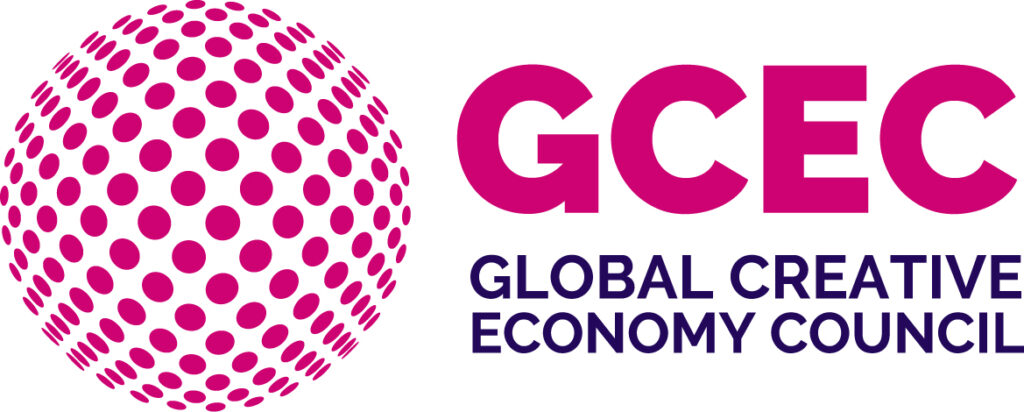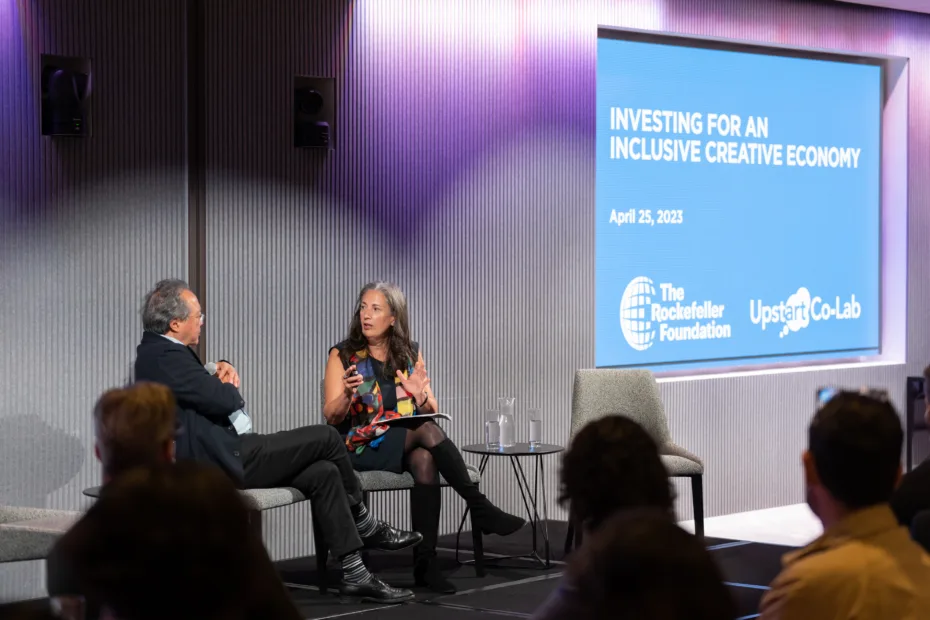Cellist Yo-Yo Ma in conversation with Upstart Co-Lab Founding Partner Laura Callanan at “Investing for an Inclusive Creative Economy”, April 25, 2023 hosted by The Rockefeller Foundation. photo: Simon Luethi
Laura Callanan (member of our Global Creative Economy Council) on the work of Upstart Co-Lab and key lessons for effective impact investing in the creative economy.

A blog from Creative PEC’s Global Creative Economy Council
My home country, the United States, is the largest global exporter of creative services and, after China, the second largest global exporter of creative goods. But, surprisingly, the terms “creative industry” and “creative economy” are not widely used in the U.S.
Many Americans mistakenly assume that all things arts and culture are handled by the non-profit sector, dependent on donations and subsidies, and not profitable. If the creative economy does come up in conversation, its significance is under-estimated. And, despite the $8.4 trillion assets under management in the U.S. following sustainable and impact investing principles, the discourse seldom stresses the creative economy’s return on investment and potential for social impact.
In its annual profile of the U.S. arts economy, the National Endowment for the Arts defined the arts and cultural sector as comprised of 35 industries. These were responsible for $1.1 trillion in economic activity in 2022 and accounted for 4.3% of the nation’s gross domestic product. However, this federal arts agency assessment did not consider important commercial creative industries like fashion (more than $556 billion in 2022) or beauty (a sector connected to personal creative expression, culture, and heritage with $92 billion market size in 2023) or video games ($106 billion market size in 2023). Nor did it account for the quickly growing creator economy ($250 billion market size in 2023).
The U.S. creative economy boasts more than growing economic power; it also has tremendous transformative capacity. It recognizes and rewards originality and merit and offers opportunities for organic business growth without significant capital infusions. This means that the creative economy is free of the roadblocks that prevent historically marginalised populations from launching new businesses and growing them to profitability. As a result, it is inherently inclusive, with numbers that speak for themselves: 35% of all women-owned businesses and 38% of businesses owned by Black, Indigenous, and people of colour in the U.S. are in the creative sector.
My organisation, Upstart Co-Lab has paved the path for impact investing in the U.S. creative economy. We started by spotlighting artists as social entrepreneurs, identified 145 creative industries as the true representation of the U.S. creative economy and made the case for investing in the creative industries to achieve market rate financial returns and deep, people-focused impact. Over the past decade, we have built a coalition of impact investors, arts leaders, and social sector partners, demonstrated how impact investing through a creativity lens can bolster under-served communities, and advised foundations and families and museums and other cultural institutions on impact investing opportunities aligned with art, design, culture, heritage, and creativity. We built a proprietary investment pipeline, from ethical fashion to sustainable food to social impact media, with more than 300 qualified opportunities. 50% of these are women-led, and 39% are led by Black, Indigenous, and people of colour. Most importantly, we have mobilized $45 million dollars for investment and field-building.
In April, we launched our Inclusive Creative Economy Strategy which seeks to deliver market rate returns for investors and five impact goals: access to capital for Black, Indigenous, people of colour, and women entrepreneurs; quality jobs for Black people, Indigenous people, people of colour, women, and people in low-income communities; vibrant communities; sustainable creative lives and pathways to a creative middle class; and an inclusive, creative economy anchored in openness and experimentation, diversity and inclusion, and tradition and innovation.
Launched with $15 million from 14 committed investors and 19 donors, the Strategy is the first impact investing vehicle for the U.S. creative industries. It is novel in other ways, too. Using a portfolio approach, we will invest in emerging funds with 50%+ exposure to the creative industries and early stage companies in the creative industries to demonstrate the range of opportunities currently available to investors across the risk-return continuum.
As we deploy this capital, Upstart will share our learnings with the goal to strengthen impact investing in the creative economy at home and around the world. After spending the past year closely analysing 16 opportunities with our investment committee and closing our first investments, three early lessons have emerged.
For the entrepreneur:
- Not every artist is an entrepreneur: Artists, designers, and other creatives may be naturally entrepreneurial, but your commitment to your companies cannot begin and end with a great idea. Like all founders, creative ones must be devoted to leading their business. See this work as an extension of your creative practice, not as a conflict to it.
For the fund manager:
- See your portfolio through a creativity lens, and your investors will too: Many funds focused on backing entrepreneurs who are Black people, Indigenous people, people of colour, women, and people in low-income communities end up investing in the creative industries because that’s where these entrepreneurs find success. By making this an intentional part of your investment thesis, your fund will grab the attention of art-loving impact investors who have been asking for opportunities connected to creativity and culture.
For the impact investor:
- Investors need to invest enough, and invest more than money: Many impact investors spread their money thin, writing scores of undersized checks to too many funds and companies. A little capital can do a lot of harm, allowing fund mangers and entrepreneurs to fail at scale rather than succeed. If you write a check, make it meaningful. And if you take a board seat, bring relevant experience, show up, and set founders up for success. First-time leaders need and deserve coaching from a qualified and engaged board.
With Upstart Co-Lab’s Inclusive Creative Economy Strategy, U.S. impact investors will finally join impact investors around the world, from Kenya to Argentina to the United Kingdom, who already prioritise the creative economy when seeking to make money and do good. We hope you will follow our progress in the coming years.
Laura Callanan is the founding partner of Upstart Co-Lab and former senior deputy chair of the National Endowment for the Arts.

